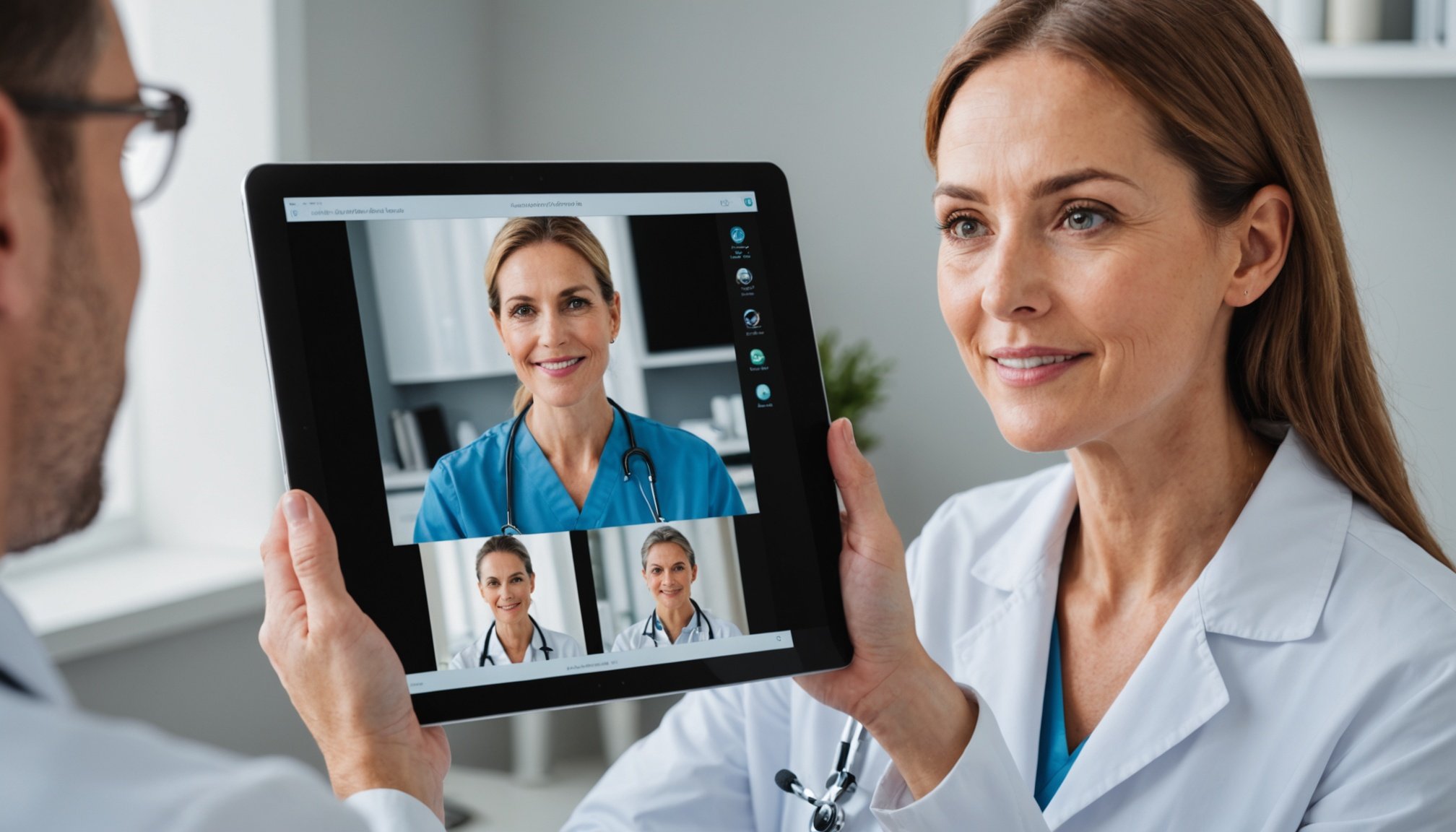Overview of Telemedicine in Dermatology
Telemedicine has revolutionised how patients access dermatology services, especially for those managing chronic skin conditions. Historically, telemedicine emerged as a solution to connect patients with healthcare providers remotely, leveraging digital communication tools. This approach significantly broadens access to specialist care, removing geographical limitations and making healthcare more inclusive.
Integrating telemedicine into existing healthcare systems entails combining traditional practices with digital platforms such as video calls, secure messaging, and digital record-keeping. This integration ensures continuity of care while maintaining patient data security and privacy. The seamless adoption of teledermatology hinges on not only technological advancements but also restructuring clinical workflow to incorporate remote consultations effectively.
Also to discover : Mastering blood sugar control: the impact of low-glycemic index diets on diabetes management
The tools and technologies used in teledermatology include high-resolution cameras for detailed skin examinations, platforms for image sharing that allow dermatologist assessments, and mobile apps that facilitate disease tracking and symptom reporting over time. These technologies empower patients to manage their conditions more proactively, providing clinicians with valuable data to tailor treatments precisely.
The robust infrastructure of telemedicine aligns with the growing demand for accessible dermatological services, presenting opportunities to transform how chronic skin care is managed globally. Looking forward, the continuous development and adaptation of teledermatology solutions are vital to address emerging challenges and improve patient care outcomes.
Have you seen this : Discover the wellness wonders: the transformative advantages of embracing a flexitarian diet
Benefits of Telemedicine for Chronic Skin Conditions
Telemedicine presents significant benefits for managing chronic skin conditions. A key advantage is enhanced access to specialists for patients residing in remote areas. By eliminating the need for travel, telemedicine allows patients to consult top dermatologists without geographic constraints. This improvement in access can be crucial for timely intervention and ongoing management of skin conditions.
Convenience is another appealing factor. Remote consultations save time, as patients can receive care from the comfort of their homes, bypassing long waiting times typically associated with in-person visits. This streamlined process not only improves patient satisfaction but also ensures that individuals adhere to their treatment plans more consistently.
Furthermore, the cost-effectiveness of telemedicine compared to traditional clinic visits cannot be understated. With reduced travel expenses and potentially lower consultation fees, remote healthcare becomes more financially accessible for patients. This affordability encourages more individuals to seek necessary care without financial barriers.
Overall, the integration of telemedicine into dermatological care addresses several logistical challenges and aligns with the growing demand for efficient healthcare delivery. As teledermatology continues to evolve, its enduring effect on chronic skin condition management becomes increasingly evident.
Patient Testimonials on Telemedicine for Skin Care
In the realm of telemedicine, capturing authentic patient testimonials is crucial to understanding its real-world impact on skin care. Many patients have shared positive feedback, highlighting the satisfaction they experience with this modern approach to managing their skin conditions. For instance, patients from rural areas report significant relief in gaining access to specialists without the burden of long-distance travel.
One illustrative real-life example involves a patient with a chronic condition; previously, they faced a five-hour commute to their dermatologist. With telemedicine, their journey became a simple log-in to a video consultation, saving time and resources. This transition allowed for remote consultations that were both convenient and effective, underscoring the satisfaction with the telemedicine experience compared to traditional visits.
Another testimonial points out the effectiveness of remote care in managing treatment adherence. Patients emphasise the ease of attending follow-up appointments, leading to more consistent treatment outcomes. This aspect of telemedicine fosters a proactive approach to health management, which many find beneficial.
In comparison to traditional consultations, telemedicine’s flexibility and accessibility offer a fresh perspective, transforming patient experiences. This evolving landscape in healthcare not only enhances patient satisfaction but also sets a precedent for the future of dermatology.
Statistical Data on Treatment Outcomes in Teletherapy
Understanding treatment outcomes in teletherapy is critical to evaluating its effectiveness. Numerous studies have shown that remote dermatology consultations can achieve outcomes comparable to traditional in-person visits. For instance, a comparative analysis of clinical efficacy revealed that telemedicine has a high rate of patient satisfaction and improvement in chronic skin care, similar to standard care settings.
Recent statistics indicate that up to 70% of patients report substantial improvements in their skin conditions following remote consultations. This figure demonstrates telemedicine’s capability to provide successful management of chronic skin conditions. Moreover, patient surveys underscore high satisfaction rates, often citing convenience and accessibility as key factors contributing to positive experiences.
A closer examination of success rates shows that telemedicine effectively facilitates timely interventions, crucial for ongoing disease management. Patients received consistent follow-ups and monitoring, enhancing their overall treatment adherence and ensuring favorable clinical outcomes.
This data emphasizes the viability of telemedicine as a treatment option for dermatological care, dispelling concerns about its efficacy compared to in-person consultations. As teletherapy continues to evolve, its integration into routine healthcare highlights its potential in transforming chronic skin care management.
Challenges in Implementing Telemedicine for Skin Care
Telemedicine, while revolutionary for dermatology, faces several implementation challenges. Firstly, technological barriers persist. These can range from inadequate internet access to the need for reliable digital devices, affecting both patients and providers. Without stable connectivity, the effectiveness of remote consultations is compromised, leading to potential lapses in chronic skin care management.
Another significant challenge is navigating the complex regulatory and reimbursement landscape. Differing regulations across regions can complicate the use of telemedicine, with providers often struggling to obtain clear guidance on billing and insurance claims. Without adequate reimbursement strategies, continued telemedicine services may become financially unviable.
Diagnostic limitations also pose hurdles. While telemedicine allows for convenient access, it cannot wholly replace the detailed physical assessments conducted during in-person visits. Some skin conditions require tactile examination, and specialised equipment that cannot be utilised remotely.
However, addressing these challenges is critical for telemedicine to flourish in dermatology. Emphasising technological inclusivity, developing coherent regulatory frameworks, and recognising the limitations of current diagnostic capabilities are essential steps toward refining telemedicine practices. Adopting innovative solutions and enhancing collaborative efforts can mitigate these barriers, ensuring that telemedicine becomes an integral component of chronic skin care.
The Future of Telemedicine in Chronic Skin Care
The world of telemedicine is on the brink of significant advancements, particularly in chronic skin care. Emerging technologies, such as artificial intelligence and machine learning, are beginning to enhance teledermatology services. These innovations can streamline diagnostics by analysing patterns in patient data, offering more accurate skin condition assessments remotely.
Looking ahead, telemedicine is poised to play a pivotal role in chronic skin care treatments. Virtual reality could transform patient education, offering immersive ways to illustrate treatment plans. Furthermore, wearable technology can monitor skin conditions in real-time, providing dermatologists with dynamic data to refine therapeutic approaches.
The advancement and integration of telemedicine require ongoing research and the ability to adapt to a changing healthcare landscape. Embracing new technologies not only improves treatment efficacy but also enhances patient engagement and adherence to care regimens. As telemedicine evolves, it remains crucial to address ethical concerns and accessibility issues that accompany technological growth.
Ultimately, the future of telemedicine in chronic skin care promises improved patient outcomes through personalised care and innovative solutions. This continued progress is imperative for transforming dermatology into a more efficient and effective discipline.








